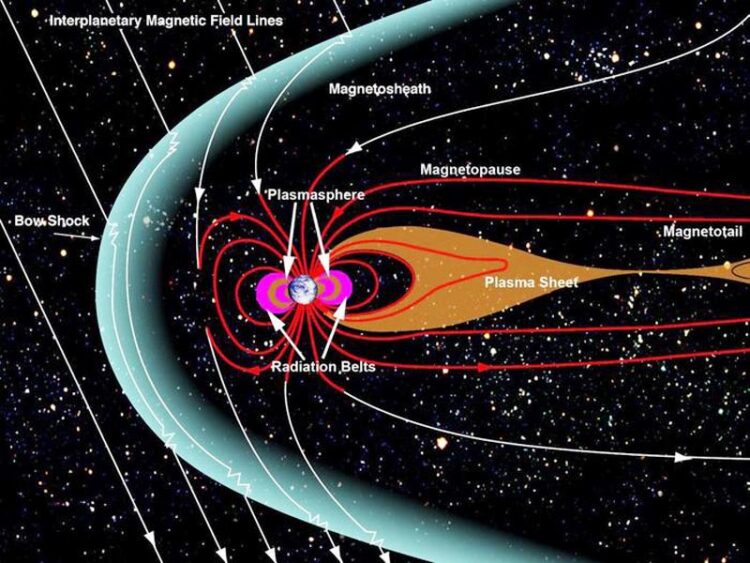Electrons from Earth may be forming water on the Moon

Graphic showing the magnetosphere and plasma sheet.
Credit: NASA/Goddard/Aaron Kaase
A team of researchers, led by a University of Hawai‘i (UH) at Mānoa planetary scientist, discovered that high energy electrons in Earth’s plasma sheet are contributing to weathering processes on the Moon’s surface and, importantly, the electrons may have aided the formation of water on the lunar surface. The study was published today in Nature Astronomy.
Understanding the concentrations and distributions of water on the Moon is critical to understanding its formation and evolution, and to providing water resources for future human exploration. The new discovery may also help explain the origin of the water ice previously discovered in the lunar permanently shaded regions.
Water content map on the surface of the Moon. Credit: Li, et al., 2023
Due to Earth’s magnetism, there is a force field surrounding the planet, referred to as the magnetosphere, that protects Earth from space weathering and damaging radiation from the Sun. Solar wind pushes the magnetosphere and reshapes it, making a long tail on the night side. The plasma sheet within this magnetotail is a region consisting of high energy electrons and ions that may be sourced from Earth and the solar wind.
Previously, scientists mostly focused on the role of high energy ions on the space weathering of the Moon and other airless bodies. Solar wind, which is composed of high energy particles such as protons, bombards the lunar surface and is thought to be one of the primary ways in which water has been formed on the Moon.
Building on his previous work that showed oxygen in Earth’s magnetotail is rusting iron in the Moon’s polar regions, Shuai Li, assistant researcher in the UH Mānoa School of Ocean and Earth Science and Technology (SOEST), was interested in investigating the changes in surface weathering as the Moon passes through Earth’s magnetotail, an area that almost completely shields the Moon from solar wind but not the Sun’s light photons.
“This provides a natural laboratory for studying the formation processes of lunar surface water,” said Li. “When the Moon is outside of the magnetotail, the lunar surface is bombarded with solar wind. Inside the magnetotail, there are almost no solar wind protons and water formation was expected to drop to nearly zero.”
Li and co-authors analyzed the remote sensing data that were collected by the Moon Mineralogy Mapper instrument onboard India’s Chandrayaan 1 mission between 2008 and 2009. Specifically they assessed the changes in water formation as the Moon traversed through Earth’s magnetotail, which includes the plasma sheet.
“To my surprise, the remote sensing observations showed that the water formation in Earth’s magnetotail is almost identical to the time when the Moon was outside of the Earth’s magnetotail,” said Li. “This indicates that, in the magnetotail, there may be additional formation processes or new sources of water not directly associated with the implantation of solar wind protons. In particular, radiation by high energy electrons exhibits similar effects as the solar wind protons.”
“Altogether, this finding and my previous findings of rusty lunar poles indicate that the mother Earth is strongly tied with its Moon in many unrecognized aspects,” said Li.
In future research, Li aims to work on a lunar mission through NASA’s Artemis programs to monitor the plasma environment and water content on the lunar polar surface when the Moon is at different phases during the traverse of the Earth’s magnetotail.
Journal: Nature Astronomy
DOI: 10.1038/s41550-023-02081-y
Method of Research: Observational study
Subject of Research: Not applicable
Article Title: Formation of lunar surface water associated with high-energy electrons in Earth’s magnetotail
Article Publication Date: 14-Sep-2023
COI Statement: The authors declare no competing interests.
All latest news from the category: Physics and Astronomy
This area deals with the fundamental laws and building blocks of nature and how they interact, the properties and the behavior of matter, and research into space and time and their structures.
innovations-report provides in-depth reports and articles on subjects such as astrophysics, laser technologies, nuclear, quantum, particle and solid-state physics, nanotechnologies, planetary research and findings (Mars, Venus) and developments related to the Hubble Telescope.
Newest articles

Innovative 3D printed scaffolds offer new hope for bone healing
Researchers at the Institute for Bioengineering of Catalonia have developed novel 3D printed PLA-CaP scaffolds that promote blood vessel formation, ensuring better healing and regeneration of bone tissue. Bone is…

The surprising role of gut infection in Alzheimer’s disease
ASU- and Banner Alzheimer’s Institute-led study implicates link between a common virus and the disease, which travels from the gut to the brain and may be a target for antiviral…

Molecular gardening: New enzymes discovered for protein modification pruning
How deubiquitinases USP53 and USP54 cleave long polyubiquitin chains and how the former is linked to liver disease in children. Deubiquitinases (DUBs) are enzymes used by cells to trim protein…


